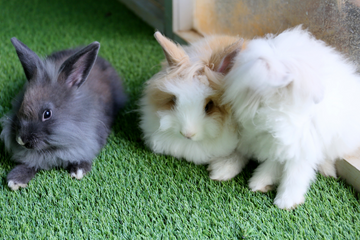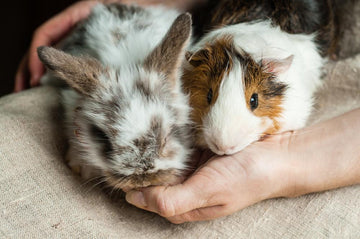Hay 101: Finding the Right Hay for Your Small Pet
When it comes to finding the right type of hay for your small pet, it's important to know about all the different types offered and their health benefits! Here are all of the hays that we offer at Rabbit Hole Hay and all you need to know about them along with how much hay we suggest you feed your rabbit, guinea pig, and chinchilla.
Click Here For a Guide to Understanding Your Rabbits Diet.

To begin the journey down our rabbit hole, let’s start with Alfalfa Hay for baby small pets:
Alfalfa Hay
Best for rabbits younger than 7 months, guinea pigs younger than 6 months, and chinchillas less than 1 year.
Alfalfa is high in minerals like calcium, as well as high in protein, however it does not have enough fiber to maintain the digestion of a healthy adult rabbit.
Alfalfa is actually a legume (a bean stock), not a grass! It has lots of very small leaves and a coarse texture.
Alfalfa is ideal for younger, growing rabbits younger than 7 months, guinea pigs younger than 6 months, and chinchillas less than 1 year as it will help them establish a healthy core weight. It can also be offered to mature rabbits, guinea pigs, and chinchillas as a treat.
Note: Because of its rich nature, it can be difficult to wean your small pet off of Alfalfa Hay, and onward to high fiber grass hays. This is a crucial transition for their health! Check with your vet, research best practices, and don’t give up.
Timothy Hay Names
We used to use the product names: First Cut, Second Cut, and Third Cut Timothy Hay. But have since replaced those product names with: Coarse, Medium, and Soft Timothy Hay.
We wanted your experience with our products to be more consistent and for you to receive what you expect with each box of Timothy Hay. Referring to a cut of hay by the order in which it was harvested from the field (first, second, and third) is an accurate and precise way to reference it, but it does nothing to describe the quality and texture you want to buy.
We found that we often used terms like soft, coarse, and leafy to accurately describe the texture of the hay to our customers. It got us thinking, what if we change the name to something everyone understands? So that’s exactly what we did.
Coarse Timothy Hay
Coarse Timothy Hay contains mostly stems, long seed heads, and leaves. The farmer usually cuts the first growth of the year by mid-June, which is why its commonly known as First Cut.
This grade of hay comes from the first harvest of Timothy Hay or an exceptionally coarse second harvest, the key to this grade is that it’s made up entirely of coarse stems and leaves.
Coarse Timothy Hay is an important staple of your small pet’s diet and dental health. Coarse Timothy is great for wearing down their teeth. It also provides the long strand fiber that helps keep your small pet’s digestion regular and functioning properly.
Medium Timothy Hay
Medium Timothy Hay contains mostly thin stems, short seed heads, and broad flat leaves. This grade of hay comes from the second harvest of Timothy Hay or a beautiful first harvest that was on the softer-side. The key to this grade of premium hay is that it’s made up mostly leaves and few stems.
After the farmer cuts the first growth of the year, commonly known as First Cut, the hay is left to regrow and is harvested a second time usually by late summer. Which is why it's commonly referred to as Second Cut.
Medium Timothy Hay is easier for small pets to eat because it is a softer hay with thinner stems and larger leaves than Coarse Timothy Hay. Medium Timothy Hay is a popular choice for aging pets who require softer food, and they still get all the nutritional benefits of Timothy Hay.
Soft Timothy Hay
The third harvest is rare, but with the right growing conditions, it can be harvested in September or October, which is why it’s commonly known as Third Cut.
For the farmer to be able to complete a third harvest the spring needs to be warm, followed by a dry and warm fall. This weather pattern is not consistent, therefore receiving a quality third harvest of Timothy Hay can be extremely difficult, if not impossible.
Our farmer has a high elevation field which stays considerably cooler than his other fields. This allows the hay to grow thinner stalks and fuller leaves, creating a second harvest that is very similar to a third harvest.
Our Soft Timothy Hay contains mostly leaves with very few stems or seed heads. This grade of hay comes from the third harvest of Timothy Hay or an exceptionally soft second harvest. Stems, if any, will be thin and occasional seed heads will be short. The key to this grade of premium hay is that it is made up almost entirely of soft leaves.
It’s good for small pets who have soft or weak teeth, making it hard to eat more coarse types of Timothy Hay. Also great for those that are extremely picky about what they offer as it still offers all the nutrients and fiber that are required for digestive health.
It can be fed as the primary source of hay, but while the softness makes it popular it lacks the coarse fiber needed to maintain dental health. That’s why you’ll need to mix in some coarse hay or provide them chew toys to maintain dental health.
Coarse Orchard Grass
Coarse Orchard Grass is high in fiber and low in protein. It’s very similar to Coarse Timothy in texture and makes a great alternative to Timothy Hay (especially if you or your pet are allergic).
Its larger seed heads, leaves, and stems provide long strands that promote natural chewing behavior that helps to keep your rabbit’s digestion functioning properly, while also maintaining dental health.
Soft Orchard Grass
Soft Orchard Grass is high in fiber and low in protein. It is the softest type of hay and makes a great alternative to Timothy Hay (especially if you or your pet are allergic).
It grows in clumps and has much longer blades of grass, minimal seed heads, very little brown leaf, and fewer stalks than other types of hay.
Small pets need coarse hay to help wear down their teeth, so a mix of Soft and Coarse Orchard Grass is a great combo for top-notch dental health.
Mountain Grass
Mountain Grass is grown at a higher elevation and is comprised of a variety of wild grasses that grow in a mountain meadow. The fields are harvested in the spring and early summer. Mountain Grass contains a variety of textures and colors, which your small pet will enjoy.
Typically Mountain Grass has fine leaves that are coarse in texture with almost no stems. Mountain Grass has the fiber required for keeping up your pet’s dental and digestive health.
Oat Hay
Oat Hay is markedly different from our other hays in two significant ways.
Oat is a grain, whereas Timothy and Orchard are grass hays.
Grain hays are much more light sensitive. Despite this, they maintain much of their nutrients despite yellowing. The stalks and leaves are very high in fiber and generally loved by rabbits, guinea pigs, and chinchillas.
Near the end of the growing season, the plant begins pumping sugars up into the seed heads to help them finish maturing. It’s long seed heads, short broad leaves, and long thick stems make it coarser, providing long strands that promote natural chewing behavior.
How Much Hay?
How much hay do I need to give my rabbit, guinea pig, or chinchilla as they grow?
Grass hay is an important staple in the diet of rabbits, guinea pigs, and chinchillas. For rabbits 7 months and older and guinea pigs 6 months and older, grass hay should make up 80% of their diet. For chinchillas older than a year, grass hay should make up 75% of their diet.
The constant foraging and grazing encouraged by hay helps to keep them physically active and mentally stimulated. It also helps to wear down their teeth while the long strand fiber helps to keep their digestion regular and functioning properly.

Fun and Unique Names for Rabbits

Healthy Rabbit Treats for Hoppy Pets









![RHDV2 Critical Information + Frequently Asked Questions [Updated 03/20/2025]](http://www.rabbitholehay.com/cdn/shop/articles/rhdv2-critical-information-frequently-asked-questions-V1.png?v=1742490107&width=360)

